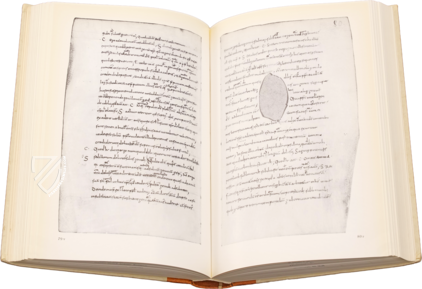The Moore Bede
(under 1,000€)
The Historia ecclesiastica gentis Anglorum or Ecclesiastical History of the English People is one of the oldest and most important historical documents in the history of England. Completed in the year 731 by Bede the Venerable, it is a history focusing on the conflict between the pre-Schism Roman Rite and Celtic Christianity in the Early Middle Ages. Bede’s first few chapters are an overview of English history beginning with Julius Caesar’s invasion in 55 BC and ending with the events of his own lifetime. Named after its former owner Bishop Tom Moore, the Moore Bede is one of the two earliest specimens of the m-type text of Bede’s Historia ecclesiastica gentis Anglorum and originates from 734–737, possibly at Monkwearmouth–Jarrow Abbey. On the last page of the manuscript, it additionally contains the Northumbrian aelda recension Cædmon's Hymn, the oldest recorded Old English poem.
The Moore Bede
Saint Bede (672/3–735), also known as Bede the Venerable, was an English monk who is credited with writing the earliest surviving history of England, which is centered around the Christianization of the island’s various Anglo-Saxon kingdoms and the establishment of the English Church. Various manuscripts of the Historia ecclesiastica gentis Anglorum or Ecclesiastical History of the English People survive today, the oldest of which resides in the library of the University of Cambridge. The detailed description of events from the years 731–734, referred to as the “Moore Annals”, indicates that the manuscript was created no earlier than 734 and various calculations of the dates of past events indicates that work on the manuscript was finished in 737 or not long thereafter.
The Origins of the English Church
Bede’s History has played a key role in the creation of a unifying English national identity that did not exist when the manuscript was made and the various Anglo-Saxon kingdoms would not be unified until the 10th century. Completed by Bede in the year 731, the original text was divided into five books, the first of which begins with the Roman invasion of 55 BC and ends with St. Augustine’s mission to England in 597. The second book begins with the death of Pope Gregory I in 604 and ends with the death of the Christian King Edwin of Northumbria in battle against the Pagan King Penda of Mercia in 633. Book 3 culminates with the Synod of Whitby in 664, a major turning point that aligned the Northumbrian Church with Roman instead of Celtic customs. The fourth book focuses on the Christianization of the Kingdom of Sussex ending in 698 and the fifth book brings the narrative up to Bede’s own day and covers the work of British missionaries in Frisia and the conflict within the Church concerning the calculation of the liturgical calendar.
Bede’s Sources
Monkwearmouth–Jarrow Abbey was an exceptional monastic institution and renowned center of learning with an excellent library. It is evident that Bede drew on the work of Roman scholars like Pliny the Elder, Orosius, Eutropius, Solinus, Josephus, and Cassiodorus as well as Christian scholars and monks including Constantius of Lyon, Gildas the Wise, and Stephen of Ripon. Bede also benefitted from corresponding with many of his contemporaries including Albinus, the abbot of the monastery in Canterbury, Bishop Daniel of Winchester, Bishop Cynibert of Lyndsey, and a certain Abbot Esi. Numerous anonymously written sources were also employed by Bede. In terms of style, Bede modelled his work on Orosius and Eusebius.
Bede’s Message
Aside from being a history of the English people, Bede used the work to advance his political and religious beliefs, favoring his native Northumbria over it southern rival Mercia. He attributes miliary defeats to a lack of faith or sinful behavior, praises Irish monks for their zealousness in comparison to their complacent English counterparts, and writes extensively over the dating of Easter, about which he disagrees with the Irish monks whom he otherwise praises. Bede emphasizes their missionizing efforts and those of their Italian counterparts while characterizing the invasion of the pagan Anglo-Saxons as divine punishment for the unorthodoxy of early British Christians. Another important theme is the evolution from diversity to orthodoxy as the native and invading races of the island are unified in a single church. The work also includes the accounts of various visions and miracles that one would expect from a medieval religious narrative, but Bede explicitly states that his goal is to use history as a tool for teaching morality.
Ownership History
The so-called Moore Bede is named after its erstwhile owner Bishop John Moore (1646–1714), who acquired it ca. 1700. It was purchased along with the rest of Moore’s library by King George I (1660–1727) and then donated by him to Cambridge University in 1715. An ex libris at the end of the manuscript on fol. 128v indicates that it had previously been held in the library of the Cathedral of Saint Julian of Le Mans after being in France for centuries, perhaps dating back to Charlemagne (747–814). It is believed that the manuscript was sent to the imperial court at Aachen at the request of its greatest scholar, Alcuin of York (ca. 735–804). There is evidence that this manuscript was created in haste: it is unadorned aside from a few decorative initials, written in Insular miniscule, a script that enabled scribes to write quickly, and there are numerous minor spelling mistakes that could be ascribed to the copyist being rushed rather than careless. On fol. 128v, there is also evidence of a second scribe writing in a Carolingian miniscule that is very similar to that used at the court in Aachen ca. 800. This and other annotations made by Frankish hands indicates that the manuscript must have left England by the end of the 8th century.
Codicology
- Alternative Titles
- Der Moore Beda
Venerable Bede's Historia ecclesiastica gentis Anglorum
Beda Venerabilis Historia ecclesiastica gentis Anglorum
Ecclesiastical History of the English People - Size / Format
- 258 pages / 29.0 × 21.5 cm
- Origin
- United Kingdom
- Date
- 734–737
- Epochs
- Style
- Script
- Anglo-Saxon minuscule
- Content
- Ecclesiastical History of the English People
Cædmon's Hymn - Previous Owners
- Bishop John Moore (1646–1714)
George I, King of Great Britain (1660–1727)
#1 The Moore Bede: an eighth century manuscript of the Venerable Bede's Historia ecclesiastica gentis Anglorum
Language: English
(under 1,000€)
- Treatises / Secular Books
- Apocalypses / Beatus
- Astronomy / Astrology
- Bestiaries
- Bibles / Gospels
- Chronicles / History / Law
- Geography / Maps
- Saints' Lives
- Islam / Oriental
- Judaism / Hebrew
- Single Leaf Collections
- Leonardo da Vinci
- Literature / Poetry
- Liturgical Manuscripts
- Medicine / Botany / Alchemy
- Music
- Mythology / Prophecies
- Psalters
- Other Religious Books
- Games / Hunting
- Private Devotion Books
- Other Genres
- Afghanistan
- Armenia
- Austria
- Belgium
- Belize
- Bosnia and Herzegovina
- China
- Colombia
- Costa Rica
- Croatia
- Cyprus
- Czech Republic
- Denmark
- Egypt
- El Salvador
- Ethiopia
- France
- Germany
- Greece
- Guatemala
- Honduras
- Hungary
- India
- Iran
- Iraq
- Israel
- Italy
- Japan
- Jordan
- Kazakhstan
- Kyrgyzstan
- Lebanon
- Liechtenstein
- Luxembourg
- Mexico
- Morocco
- Netherlands
- Palestine
- Panama
- Peru
- Poland
- Portugal
- Romania
- Russia
- Serbia
- Spain
- Sri Lanka
- Sweden
- Switzerland
- Syria
- Tajikistan
- Turkey
- Turkmenistan
- Ukraine
- United Kingdom
- United States
- Uzbekistan
- Vatican City
- A. Oosthoek, van Holkema & Warendorf
- Aboca Museum
- Ajuntament de Valencia
- Akademie Verlag
- Akademische Druck- u. Verlagsanstalt (ADEVA)
- Aldo Ausilio Editore - Bottega d’Erasmo
- Alecto Historical Editions
- Alkuin Verlag
- Almqvist & Wiksell
- Amilcare Pizzi
- Andreas & Andreas Verlagsbuchhandlung
- Archa 90
- Archiv Verlag
- Archivi Edizioni
- Arnold Verlag
- ARS
- Ars Magna
- ArtCodex
- AyN Ediciones
- Azimuth Editions
- Badenia Verlag
- Bärenreiter-Verlag
- Belser Verlag
- Belser Verlag / WK Wertkontor
- Benziger Verlag
- Bernardinum Wydawnictwo
- BiblioGemma
- Biblioteca Apostolica Vaticana (Vaticanstadt, Vaticanstadt)
- Bibliotheca Palatina Faksimile Verlag
- Bibliotheca Rara
- Boydell & Brewer
- Bramante Edizioni
- Bredius Genootschap
- Brepols Publishers
- British Library
- C. Weckesser
- Caixa Catalunya
- Canesi
- CAPSA, Ars Scriptoria
- Caratzas Brothers, Publishers
- Carus Verlag
- Casamassima Libri
- Centrum Cartographie Verlag GmbH
- Chavane Verlag
- Christian Brandstätter Verlag
- Circulo Cientifico
- Club Bibliófilo Versol
- Club du Livre
- CM Editores
- Collegium Graphicum
- Collezione Apocrifa Da Vinci
- Comissão Nacional para as Comemorações dos Descobrimentos Portugueses
- Coron Verlag
- Corvina
- CTHS
- D. S. Brewer
- Damon
- De Agostini/UTET
- De Nederlandsche Boekhandel
- De Schutter
- Deuschle & Stemmle
- Deutscher Verlag für Kunstwissenschaft
- DIAMM
- Droz
- E. Schreiber Graphische Kunstanstalten
- Ediciones Boreal
- Ediciones Grial
- Ediclube
- Edições Inapa
- Edilan
- Editalia
- Edition Deuschle
- Edition Georg Popp
- Edition Leipzig
- Edition Libri Illustri
- Editiones Reales Sitios S. L.
- Éditions de l'Oiseau Lyre
- Editions Medicina Rara
- Editorial Casariego
- Editorial Mintzoa
- Editrice Antenore
- Editrice Velar
- Edizioni Edison
- Egeria, S.L.
- Eikon Editores
- Electa
- Emery Walker Limited
- Enciclopèdia Catalana
- Eos-Verlag
- Ephesus Publishing
- Ernst Battenberg
- Eugrammia Press
- Extraordinary Editions
- Fackelverlag
- Facsimila Art & Edition
- Facsimile Editions Ltd.
- Facsimilia Art & Edition Ebert KG
- Faksimile Verlag
- Feuermann Verlag
- Folger Shakespeare Library
- Franco Cosimo Panini Editore
- Friedrich Wittig Verlag
- Fundación Hullera Vasco-Leonesa
- G. Braziller
- Gabriele Mazzotta Editore
- Gebr. Mann Verlag
- Gesellschaft für graphische Industrie
- Getty Research Institute
- Giovanni Domenico de Rossi
- Giunti Editore
- Graffiti
- Grafica European Center of Fine Arts
- Guido Pressler
- Guillermo Blazquez
- Gustav Kiepenheuer
- H. N. Abrams
- Harrassowitz
- Harvard University Press
- Helikon
- Hendrickson Publishers
- Henning Oppermann
- Herder Verlag
- Hes & De Graaf Publishers
- Hoepli
- Holbein-Verlag
- Houghton Library
- Hugo Schmidt Verlag
- Idion Verlag
- Il Bulino, edizioni d'arte
- ILte
- Imago
- Insel Verlag
- Insel-Verlag Anton Kippenberger
- Instituto de Estudios Altoaragoneses
- Instituto Nacional de Antropología e Historia
- Introligatornia Budnik Jerzy
- Istituto dell'Enciclopedia Italiana - Treccani
- Istituto Ellenico di Studi Bizantini e Postbizantini
- Istituto Geografico De Agostini
- Istituto Poligrafico e Zecca dello Stato
- Italarte Art Establishments
- Jan Thorbecke Verlag
- Johnson Reprint Corporation
- Josef Stocker
- Josef Stocker-Schmid
- Jugoslavija
- Karl W. Hiersemann
- Kasper Straube
- Kaydeda Ediciones
- Kindler Verlag / Coron Verlag
- Kodansha International Ltd.
- Konrad Kölbl Verlag
- Kurt Wolff Verlag
- La Liberia dello Stato
- La Linea Editrice
- La Meta Editore
- Lambert Schneider
- Landeskreditbank Baden-Württemberg
- Leo S. Olschki
- Les Incunables
- Liber Artis
- Library of Congress
- Libreria Musicale Italiana
- Lichtdruck
- Lito Immagine Editore
- Lumen Artis
- Lund Humphries
- M. Moleiro Editor
- Maison des Sciences de l'homme et de la société de Poitiers
- Manuscriptum
- Martinus Nijhoff
- Maruzen-Yushodo Co. Ltd.
- MASA
- Massada Publishers
- McGraw-Hill
- Metropolitan Museum of Art
- Militos
- Millennium Liber
- Müller & Schindler
- Nahar - Stavit
- Nahar and Steimatzky
- National Library of Wales
- Neri Pozza
- Nova Charta
- Oceanum Verlag
- Odeon
- Orbis Mediaevalis
- Orbis Pictus
- Österreichische Staatsdruckerei
- Oxford University Press
- Pageant Books
- Parzellers Buchverlag
- Patrimonio Ediciones
- Pattloch Verlag
- PIAF
- Pieper Verlag
- Plon-Nourrit et cie
- Poligrafiche Bolis
- Presses Universitaires de Strasbourg
- Prestel Verlag
- Princeton University Press
- Prisma Verlag
- Priuli & Verlucca, editori
- Pro Sport Verlag
- Propyläen Verlag
- Pytheas Books
- Quaternio Verlag Luzern
- Reales Sitios
- Recht-Verlag
- Reichert Verlag
- Reichsdruckerei
- Reprint Verlag
- Riehn & Reusch
- Roberto Vattori Editore
- Rosenkilde and Bagger
- Roxburghe Club
- Salerno Editrice
- Saltellus Press
- Sandoz
- Sarajevo Svjetlost
- Schöck ArtPrint Kft.
- Schulsinger Brothers
- Scolar Press
- Scrinium
- Scripta Maneant
- Scriptorium
- Shazar
- Siloé, arte y bibliofilia
- SISMEL - Edizioni del Galluzzo
- Sociedad Mexicana de Antropología
- Société des Bibliophiles & Iconophiles de Belgique
- Soncin Publishing
- Sorli Ediciones
- Stainer and Bell
- Studer
- Styria Verlag
- Sumptibus Pragopress
- Szegedi Tudomànyegyetem
- Taberna Libraria
- Tarshish Books
- Taschen
- Tempus Libri
- Testimonio Compañía Editorial
- Thames and Hudson
- The Clear Vue Publishing Partnership Limited
- The Facsimile Codex
- The Folio Society
- The Marquess of Normanby
- The Richard III and Yorkist History Trust
- Tip.Le.Co
- TouchArt
- TREC Publishing House
- TRI Publishing Co.
- Trident Editore
- Tuliba Collection
- Typis Regiae Officinae Polygraphicae
- Union Verlag Berlin
- Universidad de Granada
- University of California Press
- University of Chicago Press
- Urs Graf
- Vallecchi
- Van Wijnen
- VCH, Acta Humaniora
- VDI Verlag
- VEB Deutscher Verlag für Musik
- Verlag Anton Pustet / Andreas Verlag
- Verlag Bibliophile Drucke Josef Stocker
- Verlag der Münchner Drucke
- Verlag für Regionalgeschichte
- Verlag Styria
- Vicent Garcia Editores
- W. Turnowski Ltd.
- W. Turnowsky
- Waanders Printers
- Wiener Mechitharisten-Congregation (Wien, Österreich)
- Wissenschaftliche Buchgesellschaft
- Wissenschaftliche Verlagsgesellschaft
- Wydawnictwo Dolnoslaskie
- Xuntanza Editorial
- Zakład Narodowy
- Zollikofer AG






